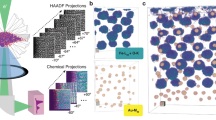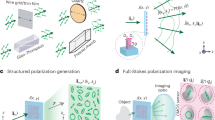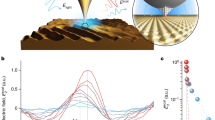Abstract
The preparation, staining, visualization and interpretation of histological images of tissue is well accepted as the gold standard process for the diagnosis of disease. These methods have a long history of development, and are used ubiquitously in pathology, despite being highly time- and labour-intensive. Here, we introduce a unique optical imaging platform and methodology for label-free multimodal multiphoton microscopy that uses a novel photonic-crystal fibre source to generate tailored chemical contrast based on programmable supercontinuum pulses. We demonstrate the collection of optical signatures of the tumour microenvironment, including evidence of mesoscopic biological organization, tumour cell migration and (lymph-) angiogenesis collected directly from fresh ex vivo mammary tissue. Acquisition of these optical signatures and other cellular or extracellular features, which are largely absent from histologically processed and stained tissue, combined with an adaptable platform for optical alignment-free programmable-contrast imaging, offers the potential to translate stain-free molecular histopathology into routine clinical use.
This is a preview of subscription content, access via your institution
Access options
Subscribe to this journal
Receive 12 print issues and online access
$209.00 per year
only $17.42 per issue
Buy this article
- Purchase on Springer Link
- Instant access to full article PDF
Prices may be subject to local taxes which are calculated during checkout



Similar content being viewed by others
References
Titford, M. & Bowman, B. What may the future hold for histotechnologists? Lab. Med. 43, e5–e10 (2012).
Buesa, R. J. Histology: a unique area of the medical laboratory. Ann. Diagn. Pathol. 11, 137–141 (2007).
Denk, W., Strickler, J. H. & Webb, W. W. Two-photon laser scanning fluorescence microscopy. Science 248, 73–76 (1990).
Zipfel, W. R. et al. Live tissue intrinsic emission microscopy using multiphoton-excited native fluorescence and second harmonic generation. Proc. Natl Acad. Sci. USA 100, 7075–7080 (2003).
Matthews, T. E., Piletic, I. R., Selim, M. A., Simpson, M. J. & Warren, W. S. Pump–probe imaging differentiates melanoma from melanocytic nevi. Sci. Transl. Med. 3, 71ra15 (2011).
Ji, M. et al. Rapid, label-free detection of brain tumors with stimulated Raman scattering microscopy. Sci. Transl. Med. 5, 201ra119 (2013).
Tao, Y. K. et al. Assessment of breast pathologies using nonlinear microscopy. Proc. Natl Acad. Sci. USA 111, 15304–15309 (2014).
Lu, F.-K. et al. Label-free DNA imaging in vivo with stimulated Raman scattering microscopy. Proc. Natl Acad. Sci. USA 112, 11624–11629 (2015).
Zipfel, W. R., Williams, R. M. & Webb, W. W. Nonlinear magic: multiphoton microscopy in the biosciences. Nature Biotechnol. 21, 1369–1377 (2003).
Sukumar, S., Notario, V., Martin-Zanca, D. & Barbacid, M. Induction of mammary carcinomas in rats by nitroso-methylurea involves malignant activation of H-ras-1 locus by single point mutations. Nature 306, 658–661 (1983).
Chowdary, P. D. et al. Molecular histopathology by spectrally reconstructed nonlinear interferometric vibrational imaging. Cancer Res. 70, 9562–9569 (2010).
Chance, B., Schoener, B., Oshino, R., Itshak, F. & Nakase, Y. Oxidation–reduction ratio studies of mitochondria in freeze-trapped samples. NADH and flavoprotein fluorescence signals. J. Biol. Chem. 254, 4764–4771 (1979).
Sutton, D. A Textbook of Radiology and Imaging (Churchill Livingstone, 1987).
Weiner, A. M. Femtosecond pulse shaping using spatial light modulators. Rev. Sci. Instrum. 71, 1929–1960 (2000).
Levental, K. R. et al. Matrix crosslinking forces tumor progression by enhancing integrin signaling. Cell 139, 891–906 (2009).
Provenzano, P. P. et al. Collagen reorganization at the tumor–stromal interface facilitates local invasion. BMC Med. 4, 38 (2006).
Provenzano, P. P. et al. Collagen density promotes mammary tumor initiation and progression. BMC Med. 6, 11 (2008).
Skala, M. C. et al. In vivo multiphoton microscopy of NADH and FAD redox states, fluorescence lifetimes, and cellular morphology in precancerous epithelia. Proc. Natl Acad. Sci. USA 104, 19494–19499 (2007).
Menendez, J. A. & Lupu, R. Fatty acid synthase and the lipogenic phenotype in cancer pathogenesis. Nature Rev. Cancer 7, 763–777 (2007).
Le, T. T., Huff, T. B. & Cheng, J. X. Coherent anti-Stokes Raman scattering imaging of lipids in cancer metastasis. BMC Cancer 9, 42 (2009).
Vander Heiden, M. G., Cantley, L. C. & Thompson, C. B. Understanding the Warburg effect: the metabolic requirements of cell proliferation. Science 324, 1029–1033 (2009).
Friedl, P. & Gilmour, D. Collective cell migration in morphogenesis, regeneration and cancer. Nature Rev. Mol. Cell Biol. 10, 445–457 (2009).
Carmeliet, P. & Jain, R. K. Angiogenesis in cancer and other diseases. Nature 407, 249–257 (2000).
Weis, S. M. & Cheresh, D. A. Tumor angiogenesis: molecular pathways and therapeutic targets. Nature Med. 17, 1359–1370 (2011).
Hanahan, D. & Weinberg, R. A. Hallmarks of cancer: the next generation. Cell 144, 646–674 (2011).
Folkman, J. & Haudenschild, C. Angiogenesis in vitro. Nature 288, 551–556 (1980).
Stacker, S. A., Achen, M. G., Jussila, L., Baldwin, M. E. & Alitalo, K. Lymphangiogenesis and cancer metastasis. Nature Rev. Cancer 2, 573–583 (2002).
Buesa, R. J. Histology without formalin? Ann. Diagn. Pathol. 12, 387–396 (2008).
Buesa, R. J. Histology without xylene. Ann. Diagn. Pathol. 13, 246–256 (2008).
Fu, D. et al. High-resolution in vivo imaging of blood vessels without labeling. Opt. Lett. 32, 2641–2643 (2007).
Min, W. et al. Imaging chromophores with undetectable fluorescence by stimulated emission microscopy. Nature 461, 1105–1109 (2009).
Mahou, P. et al. Multicolor two-photon tissue imaging by wavelength mixing. Nature Methods 9, 815–818 (2012).
González, S. & Tannous, Z. Real-time, in vivo confocal reflectance microscopy of basal cell carcinoma. J. Am. Acad. Dermatol. 47, 869–874 (2002).
Huang, D. et al. Optical coherence tomography. Science 254, 1178–1181 (1991).
Zhang, H. F., Maslov, K., Stoica, G. & Wang, L. V. Functional photoacoustic microscopy for high-resolution and noninvasive in vivo imaging. Nature Biotechnol. 24, 848–851 (2006).
Liu, Y. et al. Suppressing short-term polarization noise and related spectral decoherence in all-normal dispersion fiber supercontinuum generation. J. Lightw. Technol. 33, 1814–1820 (2015).
Lozovoy, V. V., Pastirk, I. & Dantus, M. Multiphoton intrapulse interference. IV. Ultrashort laser pulse spectral phase characterization and compensation. Opt. Lett. 29, 775–777 (2004).
Liu, Y., Tu, H., Benalcazar, W. A., Chaney, E. J. & Boppart, S. A. Multimodal nonlinear imaging by pulse shaping of a fiber supercontinuum from 900 to 1160 nm. IEEE J. Sel. Top. Quantum Electron. 18, 1209–1214 (2012).
Pegoraro, A. F. et al. Optimally chirped multimodal CARS microscopy based on a single Ti:sapphire oscillator. Opt. Express 17, 2984–2996 (2009).
Arafah, B. M., Finegan, H. M., Roe, J., Manni, A. & Pearson, O. H. Hormone dependency in N-nitrosomethylurea-induced rat mammary tumors. Endocrinology 111, 584–588 (1982).
Crist, K. A., Chaudhuri, B., Shivaram, S. & Chaudhuri, P. K. Ductal carcinoma in situ in rat mammary gland. J. Surg. Res. 52, 205–208 (1992).
Singh, M., McGinley, J. N. & Thompson, H. J. A comparison of the histopathology of premalignant and malignant mammary gland lesions induced in sexually immature rats with those occurring in the human. Lab. Invest. 80, 221–231 (2000).
Acknowledgements
This research was supported by grants from the National Institutes of Health (R01 CA166309 and R01 EB013723), the Danish Council for Independent Research – Technology and Production Sciences (FTP project ALFIE), the European Commission (EU Career Integration Grant 334324 LIGHTER) and by the Max Planck Society.
Author information
Authors and Affiliations
Contributions
H.T., Y.L. and S.A.B. conceived the idea, performed the analysis and wrote the manuscript. H.T., Y.L. and Y.Z. built the microscope and conducted optical experiments. H.T., D.T. and J.L. tested and improved the long-term stability of the fibre supercontinuum source. J.K.L. fabricated a variety of photonic-crystal fibres for the supercontinuum source. W.L.W. characterized the supercontinuum source. E.J.C., S.Y. and M.M. performed biological experiments. B.X. and M.D. built the pulse shaper. H.T. and S.A.B. obtained funding for this research.
Corresponding authors
Ethics declarations
Competing interests
M.D. is the founder of Biophotonic Solutions Inc., and has financial interest in a proprietary pulse shaping technology using multiphoton intrapulse interference phase scan (MIIPS).
Supplementary information
Supplementary information
Supplementary information (PDF 15106 kb)
Supplementary information
Supplementary Movie 1 (MOV 757 kb)
Supplementary information
Supplementary Movie 2 (MOV 381 kb)
Supplementary information
Supplementary Movie 3 (MOV 203 kb)
Supplementary information
Supplementary Movie 4 (MP4 1450 kb)
Rights and permissions
About this article
Cite this article
Tu, H., Liu, Y., Turchinovich, D. et al. Stain-free histopathology by programmable supercontinuum pulses. Nature Photon 10, 534–540 (2016). https://doi.org/10.1038/nphoton.2016.94
Received:
Accepted:
Published:
Issue Date:
DOI: https://doi.org/10.1038/nphoton.2016.94
This article is cited by
-
Variability of fluorescence intensity distribution measured by flow cytometry is influenced by cell size and cell cycle progression
Scientific Reports (2023)
-
Deep learning autofluorescence-harmonic microscopy
Light: Science & Applications (2022)
-
Plasmon-induced enhancement of ptychographic phase microscopy via sub-surface nanoaperture arrays
Nature Photonics (2021)
-
Tracking the formation and degradation of fatty-acid-accumulated mitochondria using label-free chemical imaging
Scientific Reports (2021)
-
Harnessing non-destructive 3D pathology
Nature Biomedical Engineering (2021)



